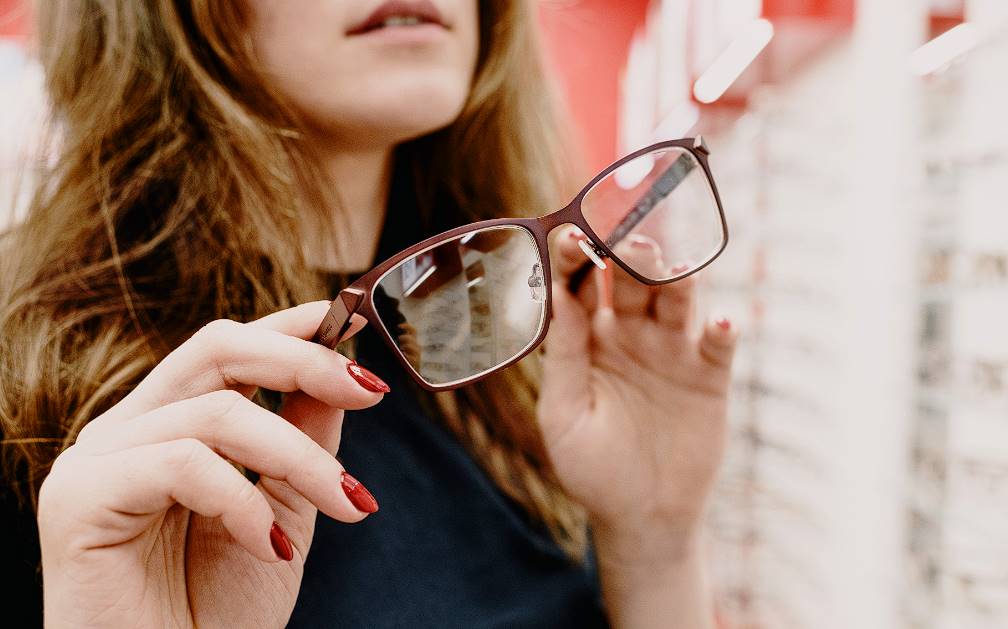Do you ever get headaches or eye strain from gazing at a screen for too long? You're not alone if that's the case. Many of us nowadays spend much time glued to electronic devices like computers, tablets, and smartphones. Our eyes might get tired and sore from staring at screens all the time. This is why glare-reducing lenses exist. But can we say for sure that they alleviate eye strain? Okay, then, let's find out.
There is some evidence that anti-glare lenses can help alleviate eye fatigue. These glasses shield your eyes from the glare of electrical devices and bright artificial lights. Anti-glare lenses assist in reducing dryness, discomfort, and blurred vision caused by eye strain by blocking some of the reflected light before it reaches your eyes. They make it easier for the eyes to stare at a screen for extended periods.
However, these advantages are not restricted to when a screen is used. The contrast and clarity of your eyesight will be improved in low-light settings thanks to anti-glare lenses. When driving at night, they can be especially helpful because they cut down on glare from oncoming vehicles and lamps. Therefore, anti-glare lenses can make a significant difference for anyone who uses a computer frequently, drives late at night, or is just looking for enhanced visual comfort.
Benefits Of Anti Glare Glasses: What, When & How It's Used
You may greatly reduce the glare from your screen by wearing anti-glare glasses. The anti-glare coating will protect your eyes from the harmful effects of computer use. Whether it's an LCD panel or a smartphone screen, glare can be caused by several factors. Wearing anti-glare glasses can prevent permanent damage to your eyesight from particles that might otherwise go unnoticed.
When Is Anti-Glare Good?
In several scenarios, having a pair of anti-glare glasses—also called anti-reflective glasses or AR-coated glasses—can be helpful. Here are a few scenarios where you could find it helpful to have anti-glare glasses on:
Outdoor Activities
Anti-glare glasses are useful for outdoor activities, especially those that take place in bright sunlight. They lessen the glare of shiny objects like water, snow, or pavement so that you can see more clearly and with less strain on your eyes.
Using a Computer for Work
The glare and reflections on a computer screen can be alleviated with anti-glare glasses, allowing for more comfortable viewing over longer periods. In addition, they help reduce computer-related weariness and eye strain.
Driving At Night
When driving at night, anti-glare glasses can aid by shielding your eyes from the brightness of incoming vehicles and city lights. Reduced glare and enhanced visibility both contribute to greater road safety.
Studying or Reading
Anti-glare glasses might be helpful when reading or studying for extended periods, especially in strong lighting. They lessen the screen's brightness, making reading simpler and protecting the eyes from strain.
Professional Settings
Anti-glare glasses are useful for reducing glare from bright lights and displays in settings like workplaces, hospitals, and laboratories. This has the potential to lessen eye strain and eliminate annoying glares.
What Are The Benefits Of Anti-Glare Glasses?
Anti-glare coatings on eyeglass lenses provide many benefits, including enhanced vision, less eye fatigue, and a more aesthetically pleasing frame. These benefits, along with others, are made possible by the anti-glare coating's ability to eliminate reflections from both the front and rear of the glasses. Modern glasses with anti-reflective coatings have virtually no light reflection. Thus, 99.5% of the incoming light is transmitted to the retina, enhancing visual acuity.
This coating makes your lenses practically invisible to onlookers and enhances the visibility of your eyes and facial features. Some people even think that anti-reflective lenses make them more beautiful.
Improved Comfort and Vision
Since your lenses won't reflect any light, more of it will reach your retina. Because of this, you won't have to squint as much, which is especially helpful when doing anything that requires a lot of focus, like driving at night or using a computer.
Enhancement of Athletic Skills
Glare is a major problem in many outdoor activities. Sports like fishing, snowboarding, skiing, and baseball are often played outside, with a greater chance of glare. Wearing sunglasses or glasses with anti-reflective coatings can help reduce this glare and improve your vision.
Enhanced Appearance
If you wear glasses without an anti-glare coating, you know how difficult it is to get a good shot or find a comfortable viewing angle for video chats. Any time you use a camera with a flash or a bright light, your lenses will reflect the light. The same holds for direct, eye-to-eye communication in well-lit settings. Reduced glare from anti-reflective lenses makes it easier for onlookers to focus on your eyes.
Eye Strain Reduction
Glare can be a major disruption during intense focus, such as when working on a computer screen. If you have to squint to read this, you’re putting unnecessary strain on your eyes. Reducing eye strain associated with these tasks and eliminating glare is a must.
Protection Against the Sun
An anti-reflective coating further blocks harmful UV radiation. Enhancing this quality with photochromatic or polarised lenses is possible.
Diminished Blue Light Intake
Dangerous blue light is emitted by almost all electronic devices, including laptops, phones, tablets, and TVs. Blue light protection, better sleep, and less eye strain are just a few of the benefits of anti-glare coatings. Many pairs of computer glasses have them to shield your eyes from harmful blue light.
Where Can I Find Anti-Glare Glasses?
Anti-glare glasses may be the answer you've been looking for to lessen eye strain caused by glare. Those who spend a lot of time in front of screens or in bright situations can benefit greatly from the reduced glare and enhanced clarity provided by these specialised eyewear solutions. This guide will help you find the best anti-glare glasses by showing you where to look for them and what to look for in a pair.
We offer a variety of alternatives to meet your requirements and tastes, including both online and in-store shopping. Put an end to distracting glare by learning where to purchase anti-glare glasses right away. The quickest approach to find out is as follows:
- A simple yet informative test for glare can be performed by tilting your glasses towards a nearby light source and carefully manipulating them. This method works with glasses, so you may check for glare without switching frames.
- The trick is to identify the hue of the reflection of your lenses. A distinct glare from your glasses indicates that the colour of the reflected light is similar to that of the source.
- The reflected light from your anti-glare glasses will give your vision a faint reddish or greenish hue. This hue lets you know that your glasses include anti-glare features that help cut down on distracting reflections.
- You can also evaluate the glasses' anti-reflective coating by measuring the intensity of the reflected light. If you notice that the reflected light is noticeably dimmer than you see without your glasses, this likely indicates that your lenses are coated with an anti-reflective material.
Tips To Prevent Eye Strain
Stress on the eyes is common. In the modern digital world, it occurs more frequently than before. Computer vision syndrome, often called digital eye strain, results from prolonged computer, smartphone, or tablet use. Some easy measures can be taken to lessen the risk of eye strain. Some of them can even be implemented right away.
The 20-20-20 Rule
One common cause of eye strain is working on a task for too long without taking a break. Every 20 minutes, take a break and do something completely different from the activity. The object of your gaze should be positioned at a distance of 20 feet, and you should stare at it for a minimum of 20 seconds. The 20-20-20 rule states as such.
You shouldn't just take a break from staring at a screen every 20 minutes; you should also look away from a demanding task for long periods throughout the day. Make sure to give your eyes a rest from staring at a screen or driving for lengthy periods by engaging in other activities that require different eye movements. If you've spent the morning at a computer, spend your lunch hour outside in the fresh air and natural light.
Position Your Screen
Check that you are holding and seeing your electronic gadget correctly. The optimal viewing distance is several feet or roughly arm's length. The ideal viewing distance from your eyes to the screen is at or slightly below eye level. The same rule applies to reading handheld digital devices: keep them below eye level. The text size can be adjusted on digital devices to make it easy to read. Most devices provide a setting to increase or decrease the text size.
Look for the Best Angle
Light pollution is a real problem. Depending on your work, the lighting could be too dim or too bright. When doing something that requires close attention, like reading, the best light source is behind you. Reduce eye strain from watching TV by turning down the lights.
In addition, make sure the screens you're using are well-lit. Just turn up or down the light as required. To avoid eyestrain, shade the windows or use filters on your electronic devices.
Accurately Multitask
When working on a computer, referring to paper documents or other resources is typical. A form or set of notes, for instance, may require transcription. When working on a computer, it's important to place any reference materials so you don't have to shift your eyes, neck, or head too often. Lessen the strain on your eyes by using a document stand to put reading material between your keyboard and screen.
Use Eye Drops
When you're concentrating very hard, especially on a screen, you can find that your blink rate drops significantly. Dry, itchy eyes are a common side effect of blinking seldom. This problem can be remedied by using eye drops, such as artificial tears. The symptom can be avoided by increasing the frequency you blink while using a screen.
Check The Air
You may be spending time in a location with subpar air quality. Using fans and air conditioners can be tiring on the eyes, as can being in a dry or polluted atmosphere. Perhaps you should:
- Use a humidifier to enhance the environment.
- Move to a place where pollution isn't as much of a problem
- Reduce the temperature or fan speed
Put on Safe Eye Protection
Consult your physician to find out if corrective eyewear is necessary to lessen the strain on your eyes. Depending on the reason for the strain, you may need eye rehabilitation, corrective lenses, or other aids. Lenses with certain coatings and colours may be beneficial to the eyes. Alternatively, you may need to reduce the amount of time you spend on contact lens wear.
Reduce Single-Activity Time
Limiting the time spent on a task that necessitates close visual attention is a simple technique to protect your eyes from fatigue. Reduce your screen time as much as possible.
Conclusion
By blocking the light from screens and artificial lights, anti-glare glasses can ease the strain and weariness that constant staring causes. By filtering out some of the reflected light before it reaches the eyes, they alleviate the dryness, discomfort, and blurred vision associated with eye strain. These eyeglasses are great for nighttime driving since they enhance contrast and clarity even in dim conditions.
Anti-glare glasses have several applications, including those in the outdoors, at the office, when driving at night, while studying or reading, and in the workplace. They make the frame seem better while also improving your vision and reducing eye strain. Anti-reflective coatings in today's glasses nearly eliminate light reflection, resulting in improved clarity of vision.
Improved comfort and eyesight, greater athletic performance, improved aesthetics, lessened eye strain, protection from harmful UV rays, and less exposure to blue light are just some of the many advantages of anti-glare eyewear. These specialised eyewear options can alleviate fatigue and improve visibility in a number of settings.
Search both online and in physical stores for the best anti-glare glasses. You can find a pair of glasses that fits your needs and preferences, whether you like to purchase them online or at a physical store. Carefully tilting glasses towards a nearby light source and adjusting them is a quick and easy way to check for glare. The anti-reflective coating of your anti-glare glasses may cause a slight reddish or greenish tint to your vision. The 20-20-20 guideline recommends taking a 20-minute break every two hours to rest your eyes and do something else that requires you to shift your eyes around.
Make sure you're a comfortable viewing distance away from your screen—several feet or about arm's length. Make reading simpler on electronic devices by increasing the text size. Find the brightest part of the room and position your lights and screens there.
Put reference items between the keyboard and the screen, use eye drops to prevent blinking, and check the air quality so you can multitask without sacrificing productivity. Improve the air quality by using a humidifier, relocating to a spot with less dust, and turning down the heat or the air conditioning.
Incorporate appropriate measures to safeguard the eyes, such as eye therapy, glasses, or contact lenses. Limiting your time in front of the screen is another way to save your eyes from strain.
Content Summary
- Anti-glare lenses can help alleviate eye fatigue caused by staring at screens for prolonged periods.
- These lenses reduce dryness, discomfort, and blurred vision by blocking reflected light.
- Anti-glare lenses improve contrast and clarity in low-light settings and are especially beneficial for driving at night.
- They are useful for outdoor activities, reducing glare from shiny objects like water and snow.
- Anti-glare glasses are helpful for computer use, reducing glare and eye strain.
- They protect against the brightness of incoming vehicles and city lights while driving at night.
- Anti-glare glasses make reading and studying more comfortable by reducing screen brightness.
- They are beneficial in professional settings to reduce glare from bright lights and displays.
- Anti-glare coatings on eyeglass lenses enhance vision, reduce eye fatigue, and improve aesthetic appearance.
- These coatings eliminate reflections from both the front and rear of the glasses, enhancing visual acuity.
- Anti-reflective lenses make your glasses practically invisible to onlookers and enhance the visibility of your eyes and facial features.
- Anti-glare glasses improve comfort and vision by allowing more light to reach the retina.
- They enhance athletic skills by reducing glare in outdoor activities.
- Anti-reflective lenses eliminate reflections in photos and videos, making it easier for onlookers to focus on your eyes.
- They reduce eye strain during intense focus, such as working on a computer screen.
- Anti-reflective coatings on glasses provide protection against harmful UV radiation.
- They reduce intake of blue light emitted by electronic devices, improving sleep and reducing eye strain.
- Anti-glare glasses can be found through online and in-store shopping.
- A simple test involving tilting glasses towards a light source helps identify the presence of anti-glare features.
- Anti-reflective lenses exhibit a faint reddish or greenish hue when exposed to light.
- Dimmer reflected light indicates the presence of an anti-reflective coating on lenses.
- The 20-20-20 rule suggests taking a break every 20 minutes, focusing on an object 20 feet away for 20 seconds to reduce eye strain.
- Optimal screen positioning and viewing distance help prevent eye strain.
- Adjusting the angle and brightness of lighting sources can alleviate eye strain.
- Using a document stand to position reference materials reduces the need to shift the eyes, neck, or head frequently.
- Using eye drops can alleviate dryness and itching caused by reduced blinking while focusing on screens.
- Improving air quality with a humidifier or moving to a less polluted environment can reduce eye strain.
- Consultation with a physician may be necessary for corrective eyewear or lenses to reduce eye strain.
- Limiting time spent on tasks that require close visual attention can protect eyes from fatigue.
- Reducing overall screen time can also help prevent eye strain.
Frequently Asked Questions
While anti-glare lenses have numerous advantages, it's important to consider a few potential drawbacks. The anti-glare coating on the lenses can be more susceptible to scratches, requiring extra care during cleaning. Additionally, the coating may slightly reduce the amount of light transmitted through the lenses, resulting in a minor decrease in overall brightness. However, these drawbacks are minimal compared to the benefits gained in terms of reduced eye strain and improved vision quality.
Yes, anti-glare lenses are beneficial for reading. When reading, especially in well-lit environments, you may experience glare from the page or reflections on the lenses. Anti-glare lenses reduce these reflections, allowing you to read more comfortably without straining your eyes. The improved clarity and reduced glare make reading a more enjoyable experience, particularly for those who spend a significant amount of time reading books or documents.
Yes, anti-glare lenses are suitable for people with sensitive eyes. If you have sensitive eyes, you may be more prone to discomfort and strain caused by glare and reflections. Anti-glare lenses help alleviate these issues by minimizing the glare and reducing the strain on your eyes. They provide a more comfortable viewing experience, making them a good choice for individuals with sensitive eyes.
Yes, anti-glare lenses can have a positive impact on the appearance of your glasses. The coating reduces reflections on the lens surface, making your glasses appear clearer and more transparent. This can enhance your overall look by eliminating distracting reflections and improving the aesthetics of your eyewear. Additionally, anti-glare lenses can make your eyes more visible to others by reducing the reflection on the front surface of the lenses.
The lifespan of anti-glare coatings can vary depending on the quality of the coating and how well you care for your lenses. On average, the coating can last between one to three years with normal use. However, factors such as frequent cleaning with harsh materials or exposure to abrasive substances can reduce the longevity of the coating. It's important to follow the manufacturer's instructions for cleaning and maintenance to extend the life of the anti-glare coating.









